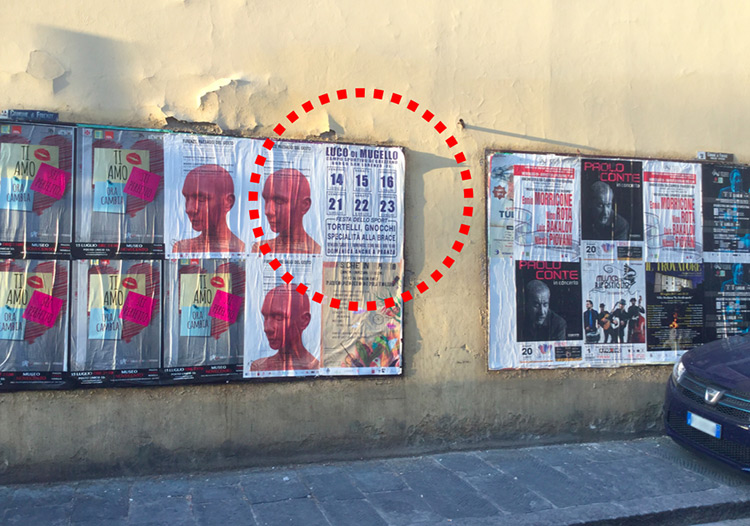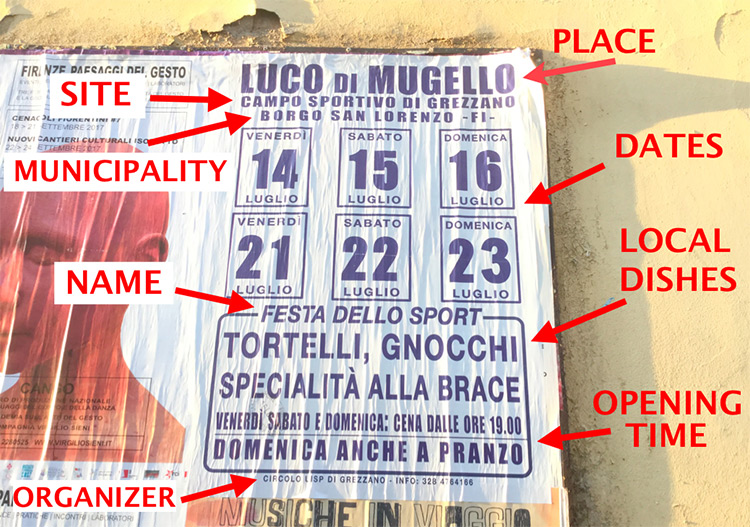How to check sagras' posters
We have in our website a great collection of Tuscan sagras, and bit by bit we'll add more, but it's clearly impossible for us to get information about all of them. According to some estimates, in a year Tuscany region has about 5000 sagras… go figure! Many sagras have no website, no Facebook page, nothing online, and it's really difficult to get information about sagras and food festivals that take place in remote villages or deep countryside, if you don't live there.
Locally, people get to know that there's a sagra mainly by the posters, in Italian language "manifesto", plural "manifesti". This rather large "manifesti" are visible everywhere, typically advertising events such as concerts, art exhibitions, fairs, markets, summer sales and so on. You'll notice them in big cities like Florence, and in the smallest hamlet. So, if you happens to be in Tuscany, and you see some manifesti, it's a good idea to spent some time checking them in search of a local festival, a sagra or whatsoever where you can have a traditional Tuscan dinner.
So here it's a guide - sort of - to find a sagra poster, and how to get from posters the information about the sagra, even if you know nothing or very few Italian. Let's start!
Posters everywhere
City walls, building walls, advertising spaces… just pay attention and you'll notice posters everywhere! Here, in Florence, a wall with posters about some summer events, mostly music concerts, classic music or pop. But there's also a typical sagra poster.

The poster advertising a sagra it's the one highlighted by the circle. It's a typical sagra poster, simple and concise, with few or no attention to aesthetic elegance, exactly as often sagras' posters are. It's in sharp contrast with the refined and special advertising graphics of all the other posters here.
Let's have a closer look.

Place
In this poster, the sagra place has the biggest importance and that's rather normal, because a sagra is strongly linked to a local identity. Luco di Mugello is a hamlet, in Italian frazione.
Site
The sagra site or location. Campo Sportivo means sports field; normally, a sagra is placed where a rather big crowd can be host and a sports field is perfect for this kind of events. "Campo Sportivo di Grezzano" means Grezzano's sports field. When you are in Luco di Mugello then, you'll have to find Grezzano which will be close to Luco di Mugello or a part of it; actually, Grezzano is a sort of hamlet too, but way smaller than the nearby Luco di Mugello.
Municipality
The "Comune" in Italian language, the municipality where the sagra takes place, it's always specified in the posters. Here, it's Borgo San Lorenzo, a nice small town in the Mugello Valley, in the Florence province, also specified in the poster: "FI" means indeed "Florence province".
Dates
The sagra will be held on six days; as many sagras, these days are on weekends, precisely on July (luglio) 14, which is a Friday (venerdì), Saturday (sabato) 15, Sunday (domenica) 16; and the next weekend, Friday 21, Saturday 22, Sunday 23.
Name
Sometimes, the sagra's name is in great evidence; in this poster, it's rather little, a "Festa dello Sport", a Sport Festival which is logical, since it's organized in a sports field.
Local dishes
Often, the sagra name evokes some delightful dish or dishes, or a typical product, like mushrooms or chestnuts or whatever; this poster gives some short information on the local dishes you'll have the luck to taste in Luco di Mugello: tortelli and gnocchi pasta, a first course; and specialità alla brace, grilled specialties as second course, a favorite of Tuscan festivals, the grilled meat.
Opening time
Watch out: on Friday, Saturday and Sunday, the dinner (cena) will start from 7 pm (dalle ore 19.00); but, on Sunday, it will be open at lunch too (anche a pranzo).
Organizer
Finally, an information, in case you need, about the organizer, with a phone number. Here, a Circolo, a local sport association. You won't probably need the phone, especially not speaking Italian.
You'll need the help of a translator of course - especially if you don't know anything of Italian, but usually the information on sagras' poster is really concise and practical, and simple to translate.


